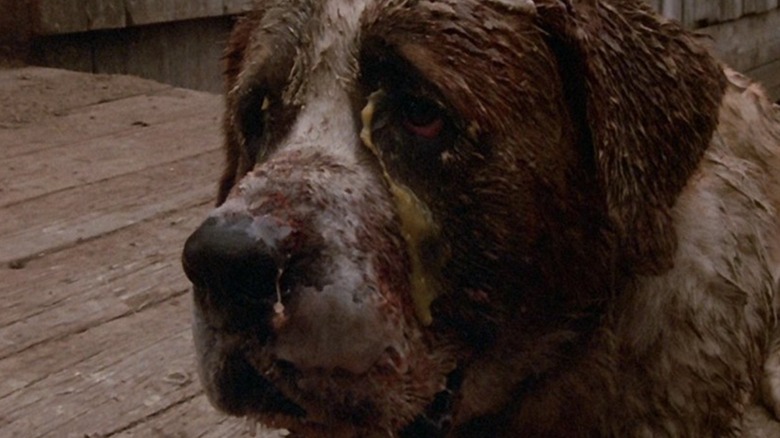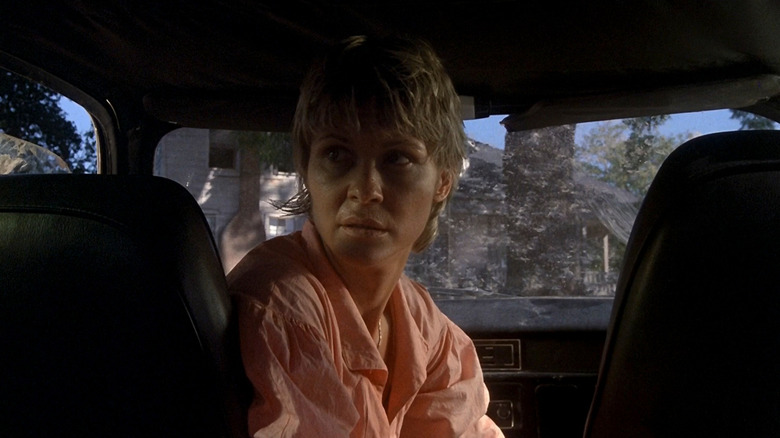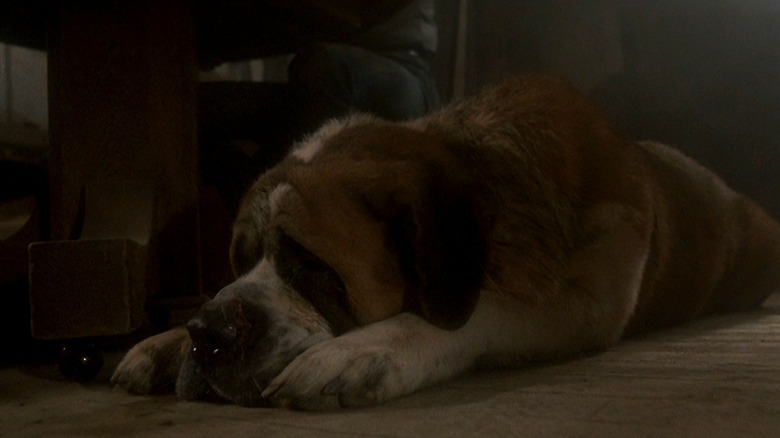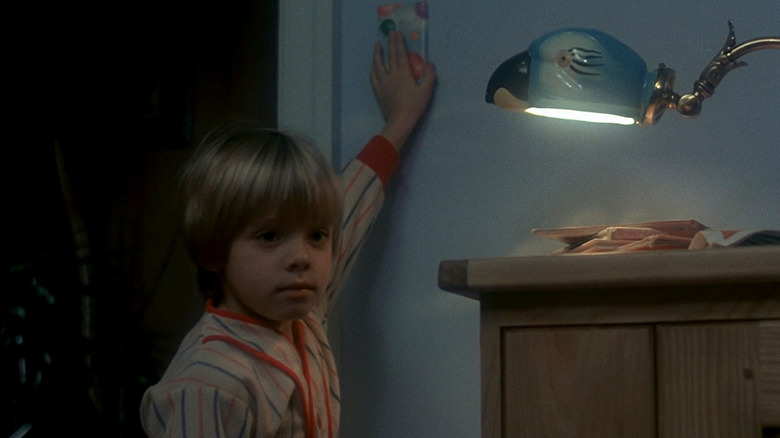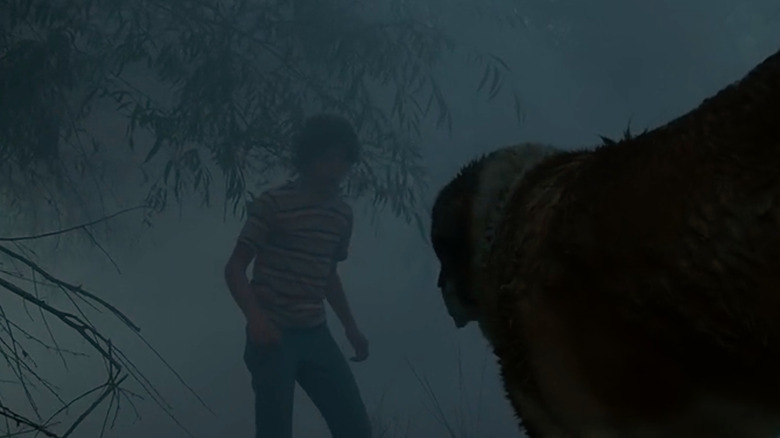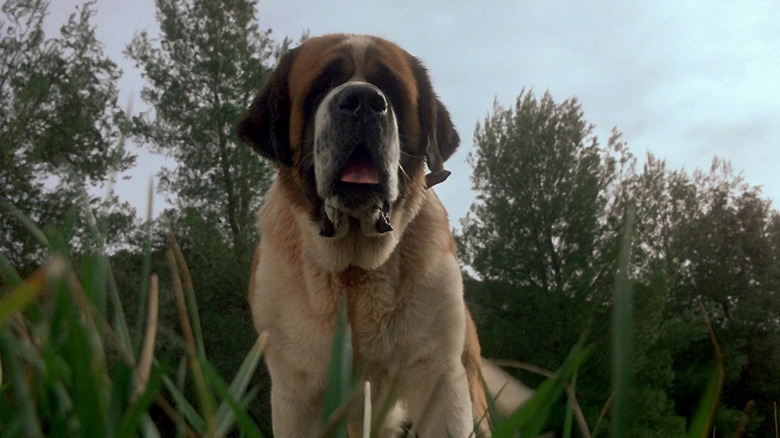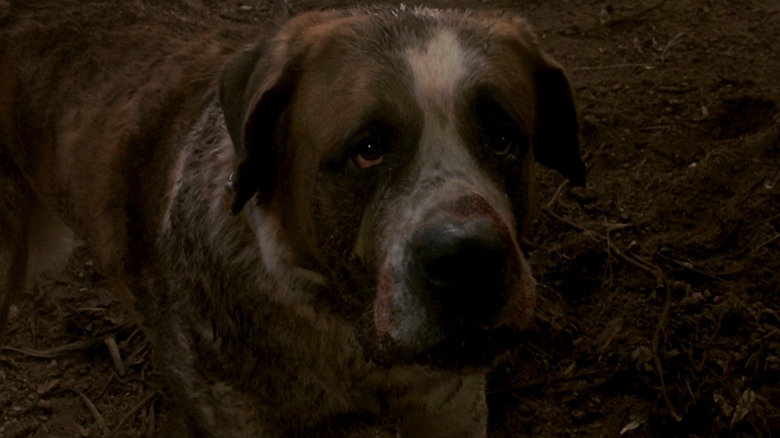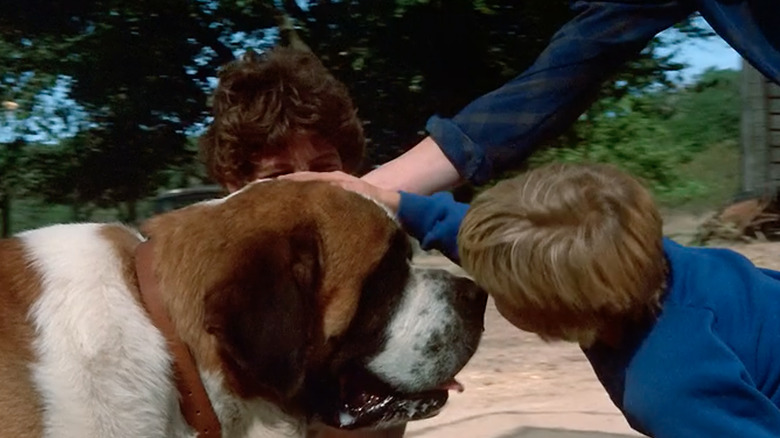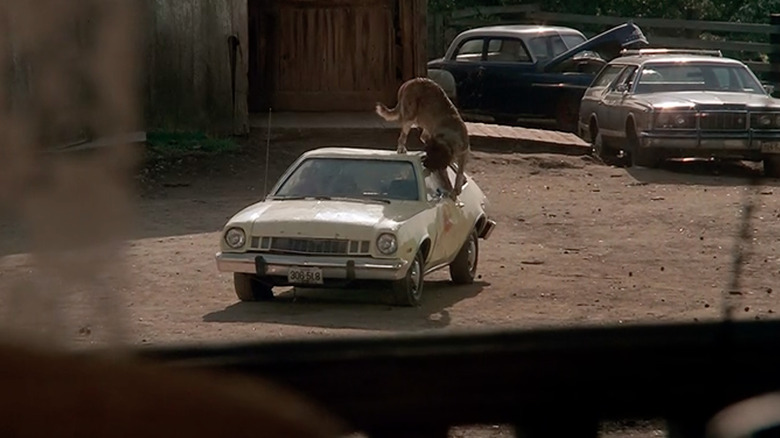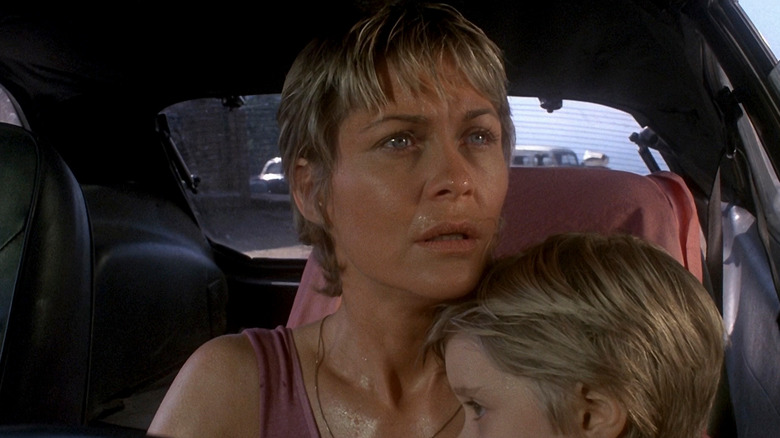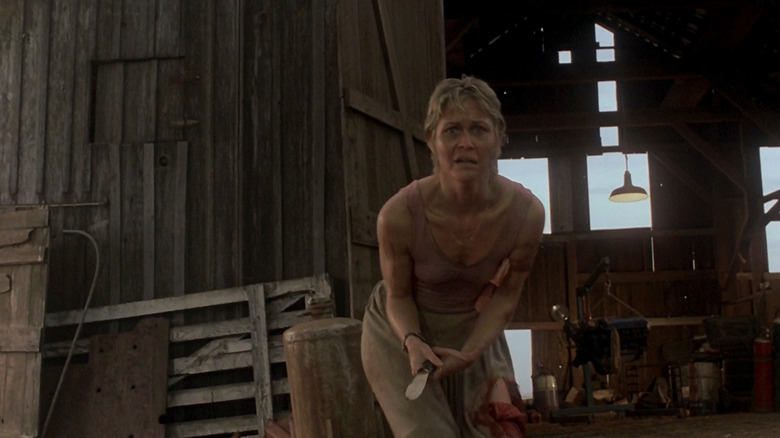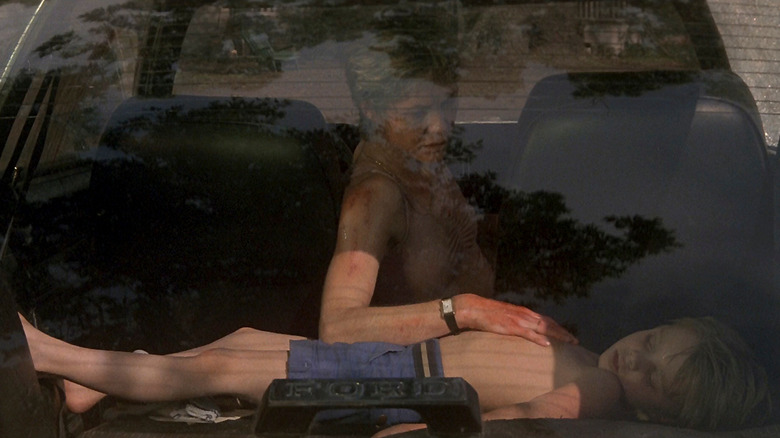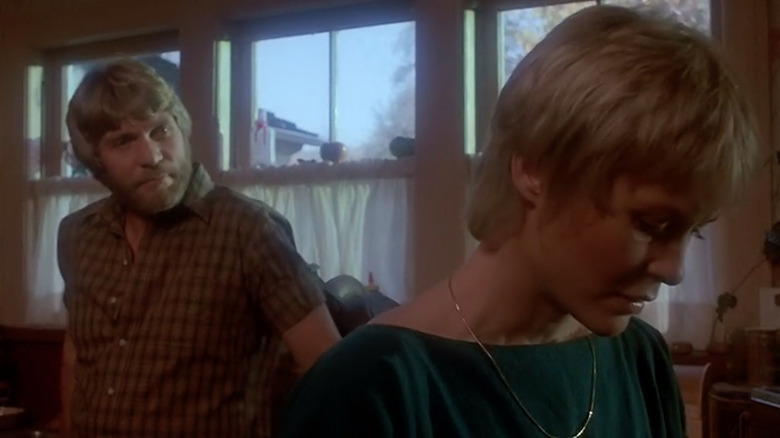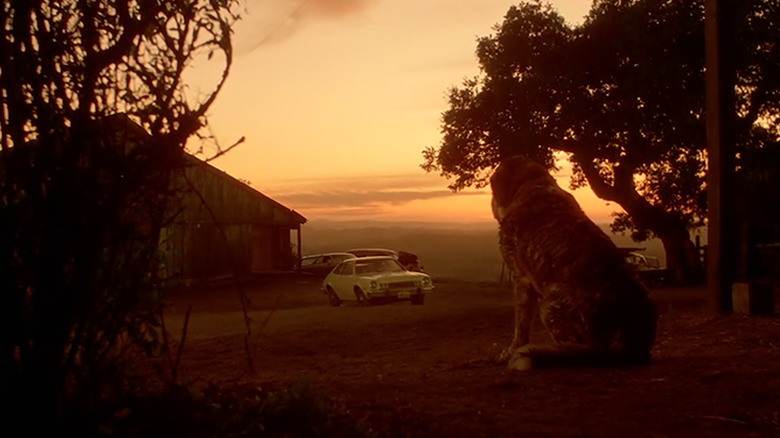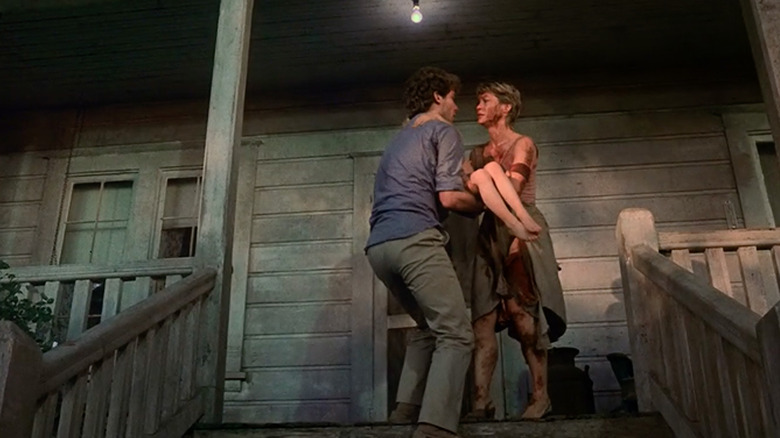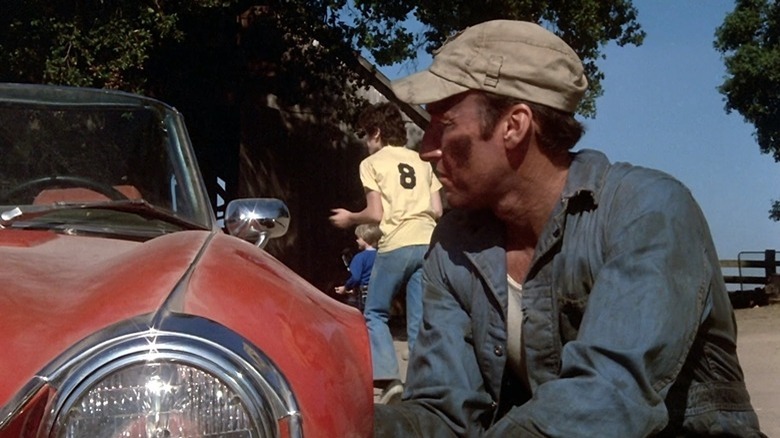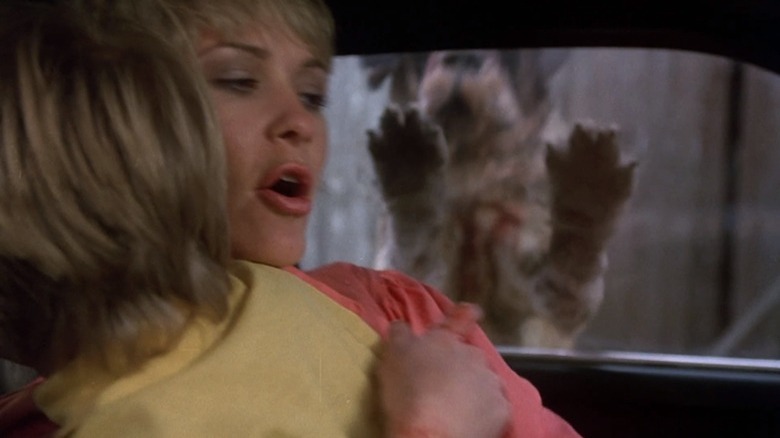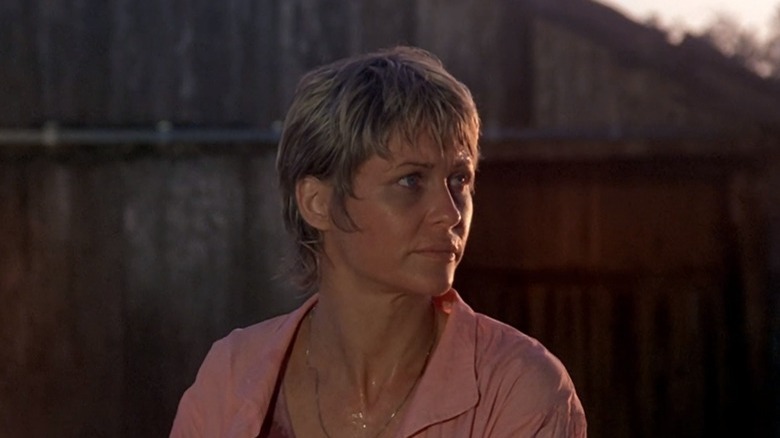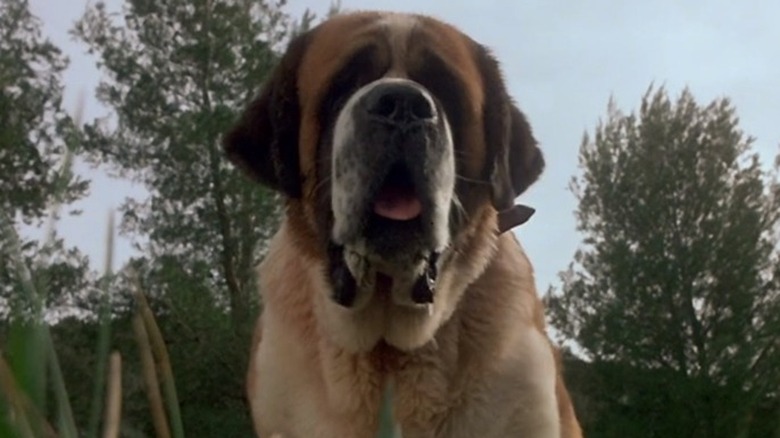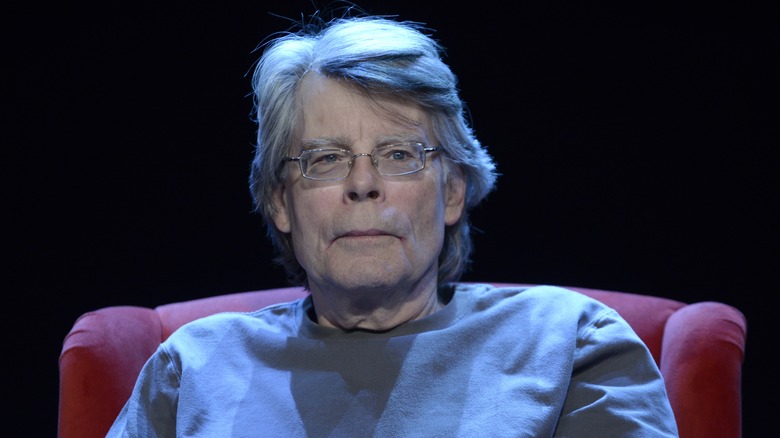Chow Down On These Cujo Facts
Horror legend Stephen King might have made a name for himself as one of the biggest names in supernatural fiction. But sometimes all you need to send shivers down spines is one really mean dog.
While his name might grace the poster, "Cujo" is actually the story of the Trentons, a seemingly perfect family who call the seaside town of Castle Rock home. Each family member is riddled with fear long before the slobbering, murderous St. Bernard enters the picture.
Donna (Dee Wallace) is afraid that she is being tied down by her domestic life and has started an affair with her husband's pal, and local carpenter, Steve Kemp (Christopher Stone). The family's patriarch, Vic (Daniel Hugh Kelly), is besought with the financial pressures of being the family's provider. And, perhaps sensing his parents' fracturing marriage, young six-year-old Tad (Danny Pintauro) is terrified of unseen toothy monsters that lurk menacingly in the shadows of his bedroom.
Ultimately, the family's fears are thrown into sharp relief when a real, genuine threat enters the picture in the grotesque form of Cujo, a local family's St. Bernard who is bit by a rabid bat while chasing down a rabbit.
Despite its smaller scale and lack of supernatural goings-on, "Cujo" really deserves to be uttered in the same breath as the rest of King's adaptations. Below you'll find some of the lesser-known parts of this creature feature's biological makeup, from bonkers stories from the set to what the heck the name "Cujo" means.
Please note that the following piece contains major story spoilers for both the novel and the film adaptation of "Cujo," as well as some spoilers for "The Dead Zone." Consider yourselves warned! And don't forget to avoid sticking your face in potential bat caves.
Stephen King doesn't remember writing the book
Stephen King has been admirably open about his struggles with substance abuse, both in interviews and within his own written fiction, where he tackles his own demons with care and persistence. King wrote "Cujo" in the late 1970s, which as he recalls to Rolling Stone, was around the same time he developed an addiction to cocaine. "That whole time is pretty hazy to me," King remembers.
In his 2000 novel, "On Writing: A Memoir of Craft," King describes how, between the coke and the blackout benders, he has no memory of writing "Cujo." "I barely remember writing [it] at all," King explains. "I don't say that with pride or shame, only with a vague sense of sorrow and loss. I like that book. I wish I could remember enjoying the good parts as I put them down on the page." While that confession is downbeat and achingly sincere, it is some small solace that King was able to pen the film's screenplay ... even if it did wind up needing to be re-written.
The original director and cinematographer dropped out early
While we can all agree that "Cujo" director Lewis Teague and cinematographer Jan de Bont did an incredible job on the final product, they are, technically, replacements.
As Scott Von Doviak relays in the book "Stephen King Films FAQ," Daniel Blatt (or at the very least someone at the studio) originally pegged Hungarian director Peter Medak for the job. Medak is best known for helming the 1980 supernatural horror film "The Changeling," which is considered by many to be one of the greatest cinematic ghost stories of all time. As Von Doviak explains: "After only one day of shooting, however, Medak departed the project (no doubt due to that eternal Hollywood bugaboo 'Creative differences')." Consequently, Lewis Teague — who according to the making of documentary, was on King's radar thanks to his creature feature "Alligator" — was handed the reins at the eleventh hour. "Any hysteria that had been previous to his showing up just went away," remembers producer Robert Singer in the film's making of documentary. "It became a real team effort."
A similar switcheroo took place with the role of director of photography. Before the camera passed to Jan de Bont (who would co on to be an accomplished director in his own right, helming the likes of "Speed" and "Twister"), the DoP on "Cujo" was the accomplished Anthony B. Richmond. As Mick Garris postulates on a segment of Trailers from Hell, it's likely that when Medak left, he took his DoP with him.
Two sets were built for the scene where Tad turns off the lights in his room
Like any child, young Tad has a good handful of reasonable phobias. After all, he's small and helpless and it's a big wide world out there full of, among other things, rabid dogs. One of Tad's fears is — we have to admit — relatable no matter what age you are. Having to walk across a dark room to your bed after turning the lights off is one hell of an adrenaline rush. And when you're as tiny and defenceless as Tad, that walk can feel more like a marathon than a hop, skip, and a jump. In one scene early in the film where Tad must perform such a feat, after turning off the lights, the space between the light switch and his bed elongates and distorts. The mattress seems miles away causing the open floor to provide ample opportunities for something to clasp at bare ankles or some such nightmarish encounter.
It's a noticeably expressionistic moment in an otherwise grounded film. As we learn in the film's making of documentary, "Dog Days," the scene was accomplished by literally building a second exaggerated set of Tad's bedroom. As director Lewis Teague explains, the length of Tad's anxiety-inducing sprint was further exaggerated by shooting the sequence in slow-motion. "There were no tricks no visual effects" explains director of cinematography Jan de Bont, "and it worked so effectively. Like, that's exactly what a kid feels." As Danny Pintauro, who played Tad, recalls: "I loved that set ... I was really amazed that they'd built this [room]."
Fire fighters responded to the scene with the fog
Early in the film, when Cujo's good-natured soul is starting to sour into something violent and predatory, there's a scene where young Brett (Billy Jayne) encounters his family's dog while searching for him in the woods. It's an incredibly eerie sequence that's made all the creepier and atmospheric by a dense, pea-soup thick fog. Brett is swallowed up by the stuff; engulfed in a dense mist that makes the scene feel especially liminal and otherworldly (a fitting tone for Cujo's last moments of anything resembling his former self, as the snarling beast manages to search within and spare poor Brett).
As director Lewis Teague explains in the making of documentary "Dog Days," the landscape had been specifically selected because of its tendency to be foggy in the early morning. Naturally, the morning of the shoot was one of the rare mornings where there was no fog. "But we had a back-up plan," Teague explains. "We had rented what they call a 'naval fogger' a machine that was used during the second world war to hide battleships at sea and puts out an enormous amount of steam." As Teague confesses: "the local fire department suddenly saw this huge column of 'smoke' coming up from this hillside that looked like a forest fire. So fortunately it was during the end of the scene that the firetrucks arrived so we didn't lose a day of shooting." Imagine the surprise of those firemen: arriving to douse a forest fire only to find a horror movie crew wielding a piece of WWII equipment.
The origins of the name Cujo are anyone's guess
In the making of documentary, American writer and critic Douglas E. Winter addresses one of the most commonly asked questions with respect to "Cujo." Namely: where does the dog's name come from? "It's not to be found in a Spanish-language dictionary, for example," Winter jokes. The author continues to explain that "Cujo" appears to be an invented name that Stephen King employed, which has since taken on a life of its own and become inseparable from any poorly behaved or out-of-pocket canine.
On the other hand, in the novel, Donna Trenton recalls that the dog shares a name with one of the members of the terrorist organization that kidnapped Patty Hearst: Symbionese Liberation Army founder William Wolf, who went by "Kahjoh." As Stephen Spignesi points out in his novel "Stephen King: American Master," in the mid-1970s King was attempting to write a novel about the infamous kidnapping. While the novel failed to materialize, as King himself explains in his 1981 non-fiction book "Danse Macabre," his research on the Hearst case ultimately formed the basis of what would become "The Stand." The specifics of why King appropriated William Wolf's nickname for the rabid mutt aren't entirely clear (other than it sounding cool), but there's no doubt that "Cujo," (as "Kahjoh" was often misspelled by the media) was knocking around King's brain around the time he needed a name for the viscous St. Bernard.
Many dogs, a robotic head, and a guy in a suit brought Cujo to life
Getting dogs to perform on cue is no easy task. But that didn't stop "Cujo" director Lewis Teague from flat out ignoring W.C. Fields' show business adage about never working with animals or children. As discussed in the making of documentary "Dog Days," despite their saintly moniker, St. Bernards are infamously difficult to train. So, while no one can agree on a number, production is said to have "employed" anywhere between five and ten dogs.
As if a pack of goopy St. Bernards wasn't enough, the production also came up with some clever workarounds for shots and scenes where using a real animal would be uncalled for (like when Cujo smashes into the car door). As Teague explains in the making of doc: "we had a man in a dog suit, we had a mechanical dog head, and we had as a backup a dog suit we could put on a Labrador retriever, which we never actually used." The suited-up Labrador was intended to show up on-screen during Brett's misty confrontation with Cujo in the woods. The idea was that the fog would mask any imperfections in the costume and the oddity of it all would lend a certain strangeness to Cujo's appearance that would signal that something in the dog had shifted. But, in the end, it just looked wrong. So, one of the normal St. Bernards was deployed.
Believe it or not, the real-life dogs couldn't stop wagging their tails
Once the rabies sets in, the loving, people-pleasing Cujo from the beginning of the film is no more. What we're left with is a nightmare that would terrify even the most ardent dog lover: an unpredictable force of nature, dripping with diseased fluids and single-minded in his desire to maul, maim, and pass along his affliction to as many poor souls as possible.
While Cujo, the character, was decidedly not having a " good " time, the canine actors who played him were having the time of their little doggy lives. Which makes sense: dog acting tends to be predicated on positive reinforcement (treats, toys, attention), so why wouldn't these fluffy thespians be excited to be doing a good job on-set?
While it's true that a wagging tail isn't categorically a sign that a dog is happy, it is a pretty reliable indicator that the dog in question is content/playful/excited. You know: emotions we don't necessarily equate to a vicious killer canine. "You know from here up [chest up] they look like they're absolutely going to eat you to death," explains Dee Wallace in the making of documentary. "From here down [chest down] we had to tie their tails in all the long shots 'cause their tails were going like this [swinging happily] because they were going to get their toy, you know?"
The dogs' motivation to attack the car was their favorite toys
If you have a pet in your life, there's a solid chance that your furry (or scaly) friend has a favorite toy. As it turns out, while performing dogs are undoubtedly better trained than most animals out there, their motivations are largely the same: food, attention, and high value rewards.
As described in the making of documentary, "Dog Days," one of the scariest scenes of "Cujo" was a lot more adorable on-set. Being trapped in a sweltering, broken-down car hounded by a rabid St. Bernard? Terrifying. A massive pooch trying their hardest to access a beloved toy? Extremely cute. As the film's animal trainer explains, Moe was the St. Bernard tasked with terrorizing the car. To achieve the impression of Moe frantically trying to infiltrate the vehicle, the trainers placed a scented fake rat in the car to lure Moe. "When [Moe] did get into the car all he did was snatch the rat," recalls actor Danny Pintauro, who portrayed Tad. "He'd got what he wanted." It's an important reminder that context is everything. Within the narrative of the film, we see a ravenous predator. But rewatch the scene with the knowledge that Moe just wanted his stinky little rodent friend and the whole mood changes.
Stephen King loves Dee Wallace's performance
As Donna Trenton, Dee Wallace is simply remarkable. In Wallace's capable hands, Donna emerges as a complicated woman. She's a caring guardian willing to do whatever it takes to protect her little boy. But she's no flawless saint. She gets frustrated, impatient, and short-tempered like any mother would. She's cheating on her husband, yes. But you get the impression that it's just something that happened rather than a malicious or calculated effort on her part to hurt Vic. Donna has a rich inner life, and that's thanks in large part to the nuance and sympathetic edge of Wallace's performance.
Naturally, Stephen King is a huge fan. As the author tweeted in January 2020, Wallace's turn as the distressed mother in "Cujo" is "one hell of a performance." In episode 109 of The Kingcast, King went into further detail: "Dee Wallace should have been nominated for an Academy Award, and in my opinion, she should have won it. She was just passed over." While the Oscars' relationship with the horror genre can charitably be described as "distant," King is nevertheless totally within his right to sing Wallace's praises. It's one of the greats as far as cinematic King adaptations are concerned.
There were originally a lot of references to 'The Dead Zone'
While "Cujo," the film is notably one of the few Stephen King horror stories without any supernatural elements, "Cujo" the book is another story. Believe it or not, there is an accepted chronological order for all of Stephen King's films set in the fictional town of Castle Rock, and the psychic thriller "The Dead Zone" takes place right before "Cujo." In the novel "Cujo," it is implied that the sudden shift in the usually friendly St. Bernard's temperament isn't just rabies-related. Instead, it's hinted that the evil spirit of Frank Dodd — the monstrous serial killer who slits his own throat before the psychic Johnny Smith can arrest him — is exerting some sort of influence over the sick pup. Furthermore, it's also implied that Dodd might be the "monster" haunting Tad's bedroom.
As the DVD commentary explains, the film adaptation of "Cujo" was going to retain some of this ambiguity, only to ultimately scrap any indication that something supernatural was going on to keep the story focused. It also probably didn't help that "The Dead Zone" film adaptation was released after "Cujo" by a couple of months, which would have made any references to the former a bit confusing. But, for what it's worth, Sheriff Bannerman makes an appearance ... right before being mauled by a snarling St. Bernard.
The film may look sweaty but it was super cold on set
There are some horror movies that feel like a sauna. You can practically feel the sweat pooling on your upper lip when you watch "The Texas Chain Saw Massacre," and the parched desert of "The Hills Have Eyes" will dry out your throat no matter how many jugs of water you chug. "Cujo" deserves to be mentioned amongst the best of them as far as "hot" horror is concerned. And the stifling heat isn't just an atmospheric touch to make you, the audience, sweat ... it's critical to the story! When Donna (Dee Wallace) and Tad (Danny Pintauro) are trapped in their broken-down car, the rabid St. Bernard isn't the only threat. Heatstroke is just on the horizon if they can't find a way to get out of their car-shaped prison.
Ironically, as balmy as it may look on-screen, in reality, the film was shot in the middle of winter. "It was down in the 40s [around 4 degrees celsius] when we were shooting," remembers director Lewis Teague in the making of documentary. As Wallace explains, heaters were placed in the car and run between takes to avoid sound problems. Glycerin was used in place of sweat (which had the unfortunate side-effect of trapping stray flies). And for his part, cinematographer Jan de Bont simulated heat by placing flames in front of the lens to create a false sense of the refraction we associate with hot air. "Every day of that shoot was taxing," recalls Tad actor Danny Pintauro, who spent much of the barnyard shoot nearly naked. "It was freezing and here we are being spritzed with sweat to make us look dehydrated."
There are a couple of connections to Joe Dante's werewolf film 'The Howling'
While horror fans who enjoy werewolf flicks and the "when animals attack" sub genre are very different breeds, there's still a solid chance that some viewers may find themselves at the center of that oddly specific Venn Diagram. If you count yourself amongst this minority, first: don't worry, you're in good company. And second: you might have noticed more than a few connections between "Cujo" and one of the most iconic werewolf films in Hollywood history: "The Howling."
Directed by Joe Dante (the man behind "Piranha" and "Gremlins") with special effects by the great Rob Botin ("The Thing," "Legend"), "The Howling" tells of a newswoman who stumbles into a commune full of werewolves. She thought a woodland retreat would help her get over her terrifying run in with a serial killer. And yet here she is once again: fighting for her life. "The Howling" and "Cujo" share two leads in the form of real-life married couple Dee Walace and Christopher Stone, who play spouses/lovers in the aforementioned films. The sneakier connection between both movies lies in their shooting locations: the Mendocino Woodlands on the North-West coast of California. Suffice to say, if you thought there was a similar vibe between the two movies you were barking up the right tree.
'Cujo' was one of the highest-grossing horror films of 1983
Horror is one of the few genres that has managed to reliably put butts in seats. It's part of the reason why most of the films developed within the Canadian Tax Shelter era were cheap, goopy genre pictures. Horror tends to break even and turn a profit, even if it's silly (looking at you, "Food of the Gods"). This isn't to say that horror carries some implicit degree of respectability or prestige that audiences are keen to. Far from it. But folks show up for horror films. And a quick look at the top-grossing films of 1983 proves that the genre was a formidable player in what folks decided to see on the big screen.
"Jaws 3-D," a technological experiment that has no right being this high on any list, was the 15th most profitable film of the year. It literally made more money than "Scarface," which comes in at number 16. "Psycho II," another sequel, is the next most profitable horror film in the 20th position, with "Twilight Zone: The Movie" coming in next at the 25th most lucrative. "Cujo" sits pretty in the 34th spot, narrowly eking out its fellow Stephen King adaptation "Christine," which holds the 35th position. (For those curious, "The Dead Zone" isn't far behind at number 37).
Stephen King stands by the new happy ending in the film
If you've had the pleasure of reading Stephen King's original novel you'll know that "pleasure" is absolutely not the right word to describe the reading experience. Somewhat famously, King does the unthinkable and kills the kid. That's right, Tad does, in fact, die of heat stroke in the book's final stretch. It's a harrowing and emotionally devastating twist of a knife that was, to be fair, already lodged pretty dang deep. Much like the cinematic outing of "The Mist," the film adaptation of "Cujo" cushions the blow not only with King's blessing, but authorial hand. In his screenplay, King allows Tad to live another day (after an emotionally manipulative fake-out, of course).
As we've mentioned previously, while King doesn't enjoy a writing credit, he did pen the first draft of the screenplay (as Scott Von Doviak notes in "Stephen King Films FAQ," the author was promoting a book in Europe and decided it was too much trouble to file a grievance with the Writers Guild of America ... which co-writer Barbara Turner did on his behalf). In any case, WGA be damned, one of the biggest alterations in the film came from King himself: Tad lives. It's the sort of change you'd expect to come from a studio note rather than an author. But King recognized that on-screen, the death of a child might be too overwhelming. "Films exist on a much more emotional level," King related to Cinefantastique magazine. "Fine, let the kid live and see how it works." Well, good news Stephen: it works.
Dark Inspirations
While "Cujo" may be a metaphor for King's addiction, the actual story has its roots in an unexpected and unsettling experience. As King writes on his website, in 1977, he needed to get his motorcycle fixed, so he went to "the middle of nowhere" to see a mechanic in Bridgton, Maine. King found himself effectively stranded in a part of the town he didn't know well on the property of a mechanic he had never met before. It's an uncomfortable situation in and of itself. Then the mechanic's huge dog lumbered into view.
As King elaborates in an interview with The Paris Review, it wasn't just the size of the dog — which was a Saint Bernard — that scared him. It was also the fact that it growled and lunged at King, despite the mechanic insisting it wasn't a dangerous dog. "Those dogs look horrible anyway, particularly in summer," the author recalled. "They've got the dewlaps, and they've got the runny eyes. They don't look like they're well." From that experience, the "villain" of "Cujo," its setting, and the mechanic/owner of Cujo Joe Camber (Ed Lauter in the film) sprang.
King was so affected by that brief interaction that he continued to turn it over in his head, imagining what might have happened if it was his wife taking in a broken down car instead of him. In this way, the story evolved from the rather frightening but ultimately still benign encounter with an aggressive dog into a tale of a mother and son facing off against a rabid canine possibly possessed by a serial killer.
Stunts Become Too Real
While "Cujo" may seem like a simple movie to film as so much of it is in one location, it still required stunt work to achieve its chilling effect. Sadly, production suffered from some stunt-related mishaps during filming that led to at least one trip to the hospital.
The worst of these happened to Dee Wallace's stunt double, Jean Coulter, as revealed Lee Gambin's book "Nope, Nothing Wrong Here: The Making of Cujo." While acting with one of the real dogs on set, excitement got the best of both.
In one scene, Coulter was supposed to lunge towards the dog and the dog — a St. Bernard named Cubby, who was specifically trained to lunge — would respond in kind. Coulter had a dog toy hidden around her neck and she teased Cubby with it to get him to come at her, which they did successfully. At one point, as Cubby tried to snatch the toy, Coulter lifted her head and Cubby caught her nose, tearing most of it off. Coulter was rushed to the hospital and luckily, a plastic surgeon was able to reattach her nose.
Star Dee Wallace was also vulnerable to danger, as she explained to Greasy Kidstuff Magazine that during a scene where she gets knocked against the car window, she accidentally hit the glass so hard that she broke through it and cut her arm. But she kept going like the pro she is, saying that "Things go wrong on every set but that's just part of shooting."
Acting Took Its Toll
The cost of "Cujo" did not stop when the film wrapped. Unfortunately for lead actor Dee Wallace, the stress of the work stayed with her even after she left set.
After filming ended, Wallace discovered she needed more support than just taking some time off. As she admitted to Den of Geek in 2007, "Cujo" was "the toughest thing I ever did." She elaborated, "[E]very scene was 'When do I break down?', 'How much do I break down?', 'How do I break down?'" She concluded by explaining that it was early in her career and she didn't yet know how to recognize when she was pushing herself too hard.
As a result, Wallace sought treatment for exhaustion after the set was struck. In 1983, she told The Washington Post that ultimately, she required two months of treatment. While the time frame of her care has varied — she told Den of Geek that she was hospitalized for three weeks — the point still stands that Wallace put her all into "Cujo" and paid the price for a great performance.
A Sad End
One of the most tragic aspects of "Cujo" is that the dog was a very sweet pet before encountering those bats. That sweetness — as later depicted in that other famous St. Bernard film "Beethoven — is closer to the breed's more typical demeanor. Although, like "Cujo," "Beethoven" also exaggerated aspects like St. Bernards' messy eating and rambunctious nature, according to The Los Angeles Times.
While the St. Bernards of "Cujo" and "Beethoven" exist on opposite ends of the behavior spectrum, they actually are linked, as dog trainer Karl Winter worked on both films with dogs that were "trained to act untrained" in very different ways.
"Cujo" employed the use of five different St. Bernards — all trained to do different actions — and one man in a St. Bernard suit to create the effect of "Cujo" (via The National Pre Bred Dog Day Newsletter). Sadly, the dog that was used most often among these big friendly dogs didn't survive long enough for "Cujo" to hit screens. He died during post-production either from bloat — a condition that involves the stomach twisting after becoming filled with fluid or gas — or an infection.
Slamming the Ban Button
Despite the novel and film both being released in the early '80s, the book's popularity continued well into the '90s. From 1990 to 1999, the American Library Association (ALA) reported that "Cujo" was the 49th most commonly banned book in the United States. This also made it King's most banned book, finishing ahead of "Carrie," "Christine," and "The Dead Zone," which also finished in the top 100 and received their own film adaptations.
According to the National Coalition Against Censorship, complaints against "Cujo" cited its sexual material, profanity, and violence as reasons for its bans in various states. Parents seemed to have a particularly difficult time with King's work, with some declaring "Cujo" to be "garbage" and "filthy" and one parent unequivocally stating, "I object to any book by Stephen King as he writes horror fiction, which has no value" (via The Censorship of Stephen King).
The Censorship of Stephen King notes how although some parents expressed their concerns by filing official complaints with the school or town libraries, others went to more extremes by throwing the books in the trash or requesting a restricted area in the library for the placement of "Cujo" and similar books.
Interestingly, no King books made the top 100 in the subsequent two decades, while arguably less scary novels like selections from R.L. Stine's "Goosebumps" series did.
